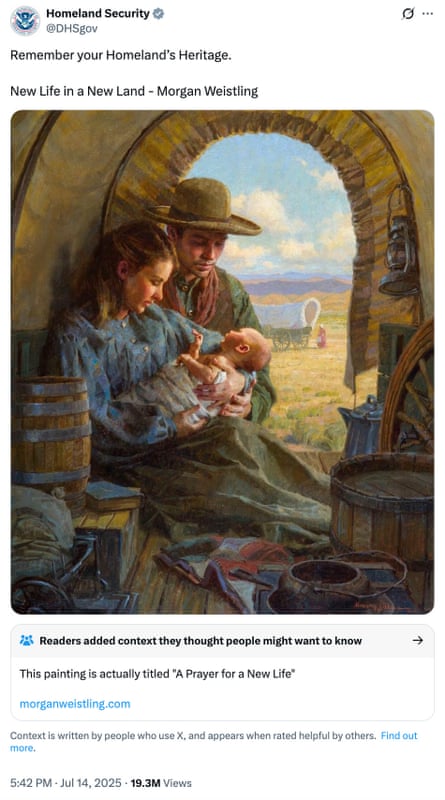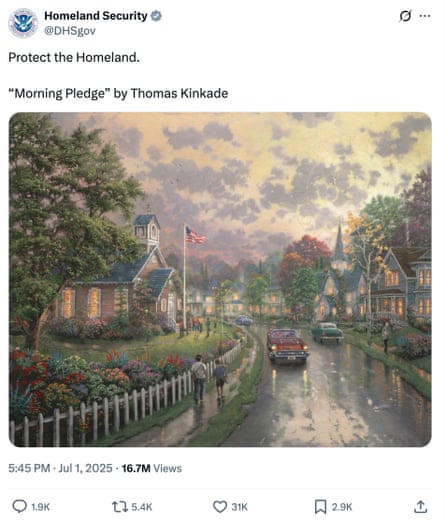In Morgan Weistling’s oil painting A Prayer for a New Life, a young, white pioneer couple sit inside a covered wagon, sharing a quiet moment with their swaddled newborn as prairie stretches out behind them. The work could be interpreted as a western take on the birth of Jesus; Mary and Joseph on the Oregon trail. One might imagine it decorating the oak-walled office of an oil executive in a Yellowstone spin-off show – though it is probably too schmaltzy even for that.
Last week, Weistling’s painting took on a darker meaning when the Department of Homeland Security (DHS)’s official X account posted, to the artist’s consternation, an image of the painting with the caption: “Remember your Homeland’s Heritage.”
To some, the post seemed like authoritarian propaganda, similar to what was put out by Joseph Goebbels about Aryan motherhood in 1930s Nazi Germany. “In case you had any doubts about the white supremacist thing,” one X user responded to the post.
Others nakedly applauded its perceived subtext, a celebration of the right’s vision for America, in which families of strong men and maternal women usher in a pronatalist baby boom. “Our people. Our place,” responded Andrew Torba, CEO of Gab, a social network popular among alt-right, neo-Nazi and white nationalist users.
Under Trump’s second administration, the DHS has orchestrated sweeping immigration raids across the US, and Ice is reportedly detaining a record number of migrants. A scroll through the department’s X account shows videos of families torn apart by immigration officers, and then this post, which seems to say: we’re fine with migration and movement – so long as the families doing it are white.

Experts say the benign look on the couple’s faces and the presence of an innocent newborn distract from the real problem: what’s not in the painting’s frame.
“The main stories that are told through art of the American west tend to focus on white settlers, which omits the suppression of other populations,” said Emily C Burns, director of the Charles M Russell study for the center of art of the American west and an associate professor of art history at the University of Oklahoma. “It’s challenging when a single image of something that is incredibly complicated is placed in the foreground. What stories are lost in that?”
Those stories include the US government’s violent expulsion and genocide of Indigenous people to clear land for settlers, and the Black cowboys, many of them formerly enslaved or one generation removed from slavery, who went west on horseback and helped develop the country’s nascent ranching industry. Also omitted are the Chinese immigrants who built the west’s railroads and worked its goldmines and factories, and who, due to the Chinese Exclusion Act of 1882, could not legally gain US citizenship.
Adam Klein, associate professor at Pace University, studies how extremist movements infiltrate American media and politics. “The [Weistling] painting isn’t violent at all,” he said. “On the surface, it’s a beautiful image. But when you look at where it’s coming from, with [DHS using] language like ‘homeland’ and ‘heritage’, that’s really evocative of anti-immigrant sentiment.”
Klein said the post brought to mind similar themes used by VDare, a far-right, anti-immigration website that launched in 1999 and suspended operations last year. VDare was named after Virginia Dare, the first child born to European settlers in the “new world”. Since the 1800s, white supremacists have glorified her memory, though all we know of her is her birthdate and the fact that she disappeared as part of the “lost colony” of Roanoke. Dare’s image and disappearance are ripe for racist projections, including the conspiracy theory of a “white genocide” perpetrated by non-white immigrants.
In 2018, the VDare founder Peter Brimelow told the Washington Post that he chose the name “to focus attention on the very specific cultural origins of America, at a time when mass nontraditional immigration is threatening to swamp it”.
Klein also noted that the DHS’s post seemed like “an attempt to stir the pot and be divisive”.
Under the leadership of Kristi Noem, the DHS has taken up Donald Trump’s orders for mass deportation with militant aplomb and an all-out publicity blitz. Noem looked glamorous as she livestreamed pre-dawn Ice raids in New York and toured the southern border on horseback. Meanwhile, the department shares mugshots of migrants and reminders from Uncle Sam to “REPORT ALL FOREIGN INVADERS.” Last month, it posted AI-rendered art hyping Alligator Alcatraz, thumbing its nose at critics horrified by the detention center’s reported conditions.

On a less aggressive artistic note, it also shared the late artist Thomas Kinkade’s Morning Pledge, a pastoral painting showing two boys walking to their small-town schoolhouse underneath a fluttering American flag. “Protect the Homeland,” the DHS captioned this post.
Both Kinkade’s perfectly manicured Americana and Weistling’s “manifest destiny” daydream belie the chaos DHS has sown through its often violent immigration crackdown. But they do align with the retrograde America Trump 2.0 desires, and is ordering US universities, museums and national parks to teach.
Weistling, who did not respond to a request for comment, wrote on his website that DHS used his 2020 painting without permission. He described the work as two parents with their baby, “depicted here praying to God for his fragile life on their perilous journey”. His style often canonizes traditional domestic roles: girls and young women cook and clean, while men ride on horseback and build things.
When asked about its social media strategy, including the use of Weistling’s work, a DHS spokesperson wrote via email: “If the media needs a history lesson on the brave men and women who blazed the trails, forded the rivers, and forged this Republic from the sweat of their brow, we are happy to send them a history textbook. This administration is unapologetically proud of American history and American heritage. Get used to it.”
Renee Hobbs, a professor of communication studies at the University of Rhode Island and founder of the Media Education Lab, says that she teaches her students “the four pillars of propaganda”: activating strong emotions; simplifying information and ideas; appealing to people’s deepest hopes, fears and dreams; and attacking opponents. The DHS’s post hits all of these pillars.
“This could be an image from a children’s book,” Hobbs said. “It’s a vision of America that was sold to generations. I’m a boomer, and I read these kinds of stories as a child. Now I have a critical perspective on manifest destiny, but this taps into my memory, which can bypass critical thinking.”
Those feelings, good or bad, are the whole point: “DHS is looking for engagement, and the use of emotional imagery gets people to react, whether they love it or hate it,” Hobbs said. “So from a PR strategy, these posts are actually working quite well.”

 German (DE)
German (DE)  English (US)
English (US)  Spanish (ES)
Spanish (ES)  French (FR)
French (FR)  Hindi (IN)
Hindi (IN)  Italian (IT)
Italian (IT)  Russian (RU)
Russian (RU)  1 day ago
1 day ago
























Comments